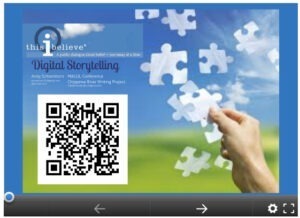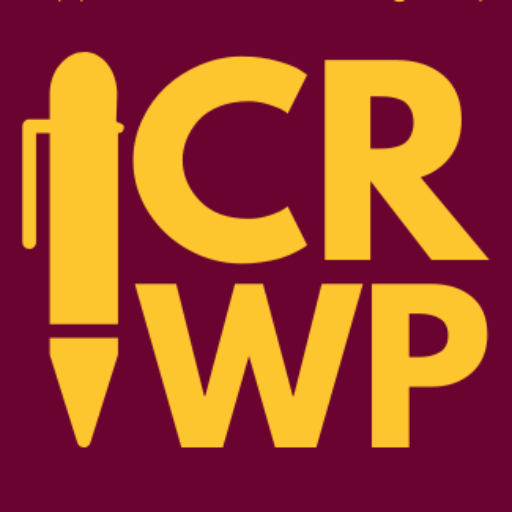This post is the first in a series about 2016-17 partnerships between the CRWP and various school administrators, community librarians, and other educational leaders.
Last January, the CRWP asked a hand-selected group of school administrators, community librarians, and other educational leaders the following questions:
- Do you believe in the transformative power and importance of reading, writing, and digital literacy?
- Do you see value in the National Writing Project network but have been unable to join because of time constraints associated with a four-week summer institute?
- Is there an innovative educational initiative on your to-do list that you have been unable to complete (or even begin)?
- Would you like to be a published author, with support from accessible and experienced, published teacher-scholars?
To each of these questions, Tinna Mills, who is the teen librarian at Veterans Memorial Library in Mt. Pleasant, answered yes, and now she’s partnering with the Chippewa River Writing Project to help her teens produce digital stories about their transforming experiences associated with teen services at the library. To learn about library teen services and the digital story initiative, keep reading …
………….
The Background
For quite some time, Tinna had wanted to invite her teens to craft digital stories about teen services at the public library. Her thought was that these digital stories could be posted on the library webpage, the better to promote PR, market services, and extend outreach. In addition, she believed that the digital stories would provide data to measure the effectiveness of the teen services offered at the library by means of a new assessment tool—a topic addressed momentarily.
In spite of how much Tinna valued the idea of these digital stories, her overtasked work schedule and the Teen Advisory Board’s (TAB) busy agenda kept her from putting the project into action.
Project Timeline
Work on Tinna’s project began in June when she and three teen leaders did a “repeat performance” of a presentation they had delivered in March at the 2016 Michigan Library Association Conference—very impressive. The presentation was titled “Let Them Lead,” and a small but interested group representing the CRWP, Friends of the Library, Sacred Heart Academy, and other community organizations came to listen. The gist of the talk was twofold: First, teens are more likely to participate in teen services if THEY are the ones who plan and implement the activities. Using this approach, teen services offer a panoply of services, including Pizza and Page, Movie Mania, and College 101, as well as lock ins, volunteer opportunities, and more (to name just a few). Second, the most accurate way to measure the effectiveness of library services is not the traditional way of counting (counting books, bodies, and so on); instead, a more accurate way is to align the services with the 40 Developmental Assets Model. According to Tinna, this model purports that teens need forty external and internal assets to grow adults who are “healthy, caring, and responsible.” As the name of the model suggests, these assets are forty in number, and they fall into five overlapping categories: support, empowerment, boundaries/expectations, time management, commitment to learning, positive values, and social competencies, and positive identity.

Over the summer, Tinna’s teen participants have reviewed a set of digital stories representing a wide range of topics, purposes, and perspectives, including a digital story called “The Seven Elements of Digital Stories” (found on the CRWP wiki, thanks to Andy Schoenborn). These digital stories helped Tinna and her group decide that LIBRARIES TRANSFORM would be the overarching theme of the project, as well as all of the digital stories, because it is the 2016-17 theme of the American Library Association and it is responsive to the 40 Developmental Assets Model. In addition, reviewing a range of digital stories helped to clarify the shape and scope that the digital stories would take for this project. More specifically, teens will explore just one or two ways that a library service has positively impacted their lives, and so they will write from a personal, first-person perspective. Finally, Tinna agreed that iMovie was the best choice in software for the digital stories because of the MACs that the library has already purchased. A back-up option is WeVideo.
This fall, the teens will begin writing their own digital stories. As a starting point, though, they’ll be recursive by initially examining a second set of mentor texts, with thanks (again) to Andy Schoenborn. As part of the project, Andy sought permission from four former students—Jeff Patton, Katie Zwick, Katie Flanagan, and Rachel Christie, who explored in their digital stories how a single experience led to transformation and personal growth—a theme and perspective consistent with the plans for Tinna’s project. Best of all, two of the four students (Jeff Patton and Katie Zwick) attend college at CMU, which is close enough for them to give an author’s talk at the library about their own writing processes in crafting a digital story and/or what they regard as the distinctive craft elements of their final products. These same students may also be invited to provide guidance as Tinna’s teens select topics for their digital stories and begin/continue the drafting process.
Tinna knows that the drafting process will take time, and that her teens will work at their own pace–a given, considering that Let Them Lead continues to be her mantra. As soon as a few digital stories are complete, though, Tinna hopes to post them on the library webpage, which she believes will foster enthusiasm and motivation for other teens to complete and publish their digital stories too.
Final Outcomes
By Summer 2017, Tinna hopes that she will have a solid collection of digital stories posted on the library webpage that demonstrate how library services have transformed her teen participants and, further, that teens will be motivated to consider crafting a digital story on new topics: children’s services, book trailers, and more. In addition, Tinna hopes that her assessment work using the 40 Developmental Assets Model will be underway. Finally, she has the opportunity to co-author a book chapter and/or article about her experiences working with the CRWP on this project.
It’s possible, too, that Tinna’s teens, having crafted their own digital stories, will have the desire to begin a community literacy initiative in which they teach younger library patrons how to write own digital stories.
***********
Stay tuned for future blog posts about this and other CRWP partnerships!
 Elizabeth Brockman is a founding co-director of the Chippewa River Writing Project. A former middle and high school English teacher, Elizabeth is currently a professor in the English Department at CMU, where she teaches composition and composition methods courses.
Elizabeth Brockman is a founding co-director of the Chippewa River Writing Project. A former middle and high school English teacher, Elizabeth is currently a professor in the English Department at CMU, where she teaches composition and composition methods courses.

This work is licensed under a Creative Commons Attribution-NonCommercial-ShareAlike 4.0 International License.

Leave a Reply
You must be logged in to post a comment.